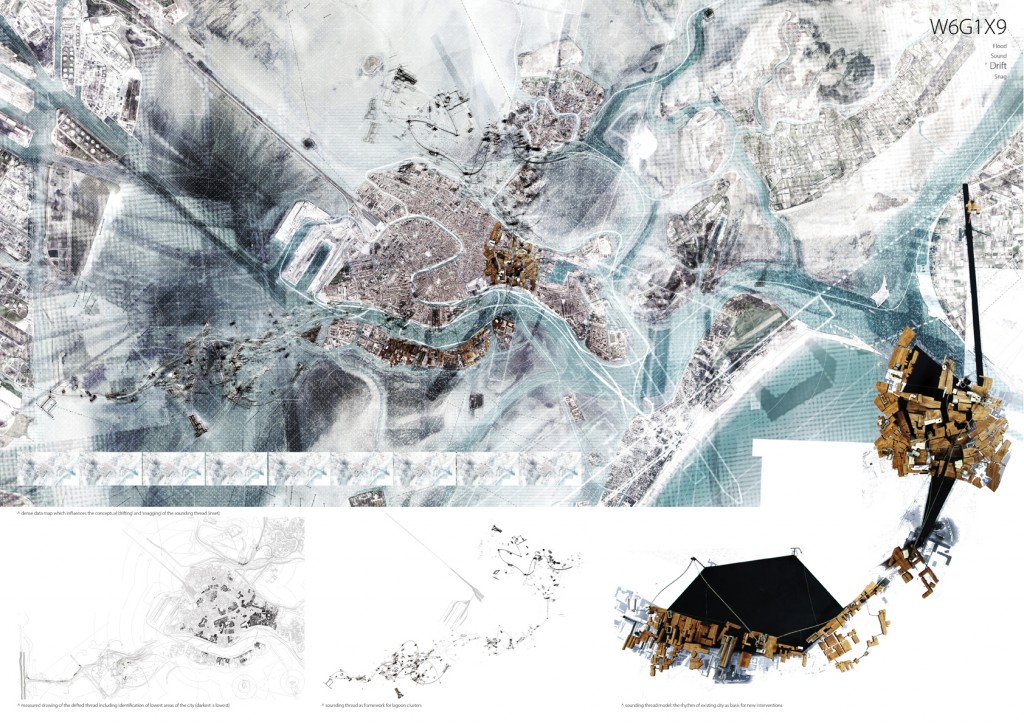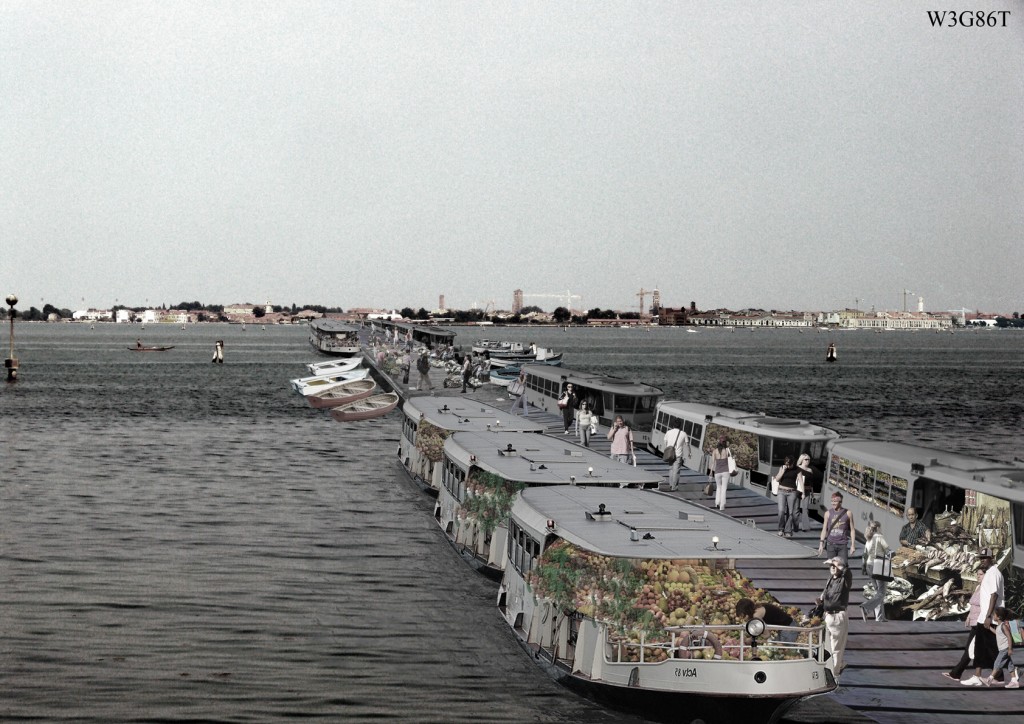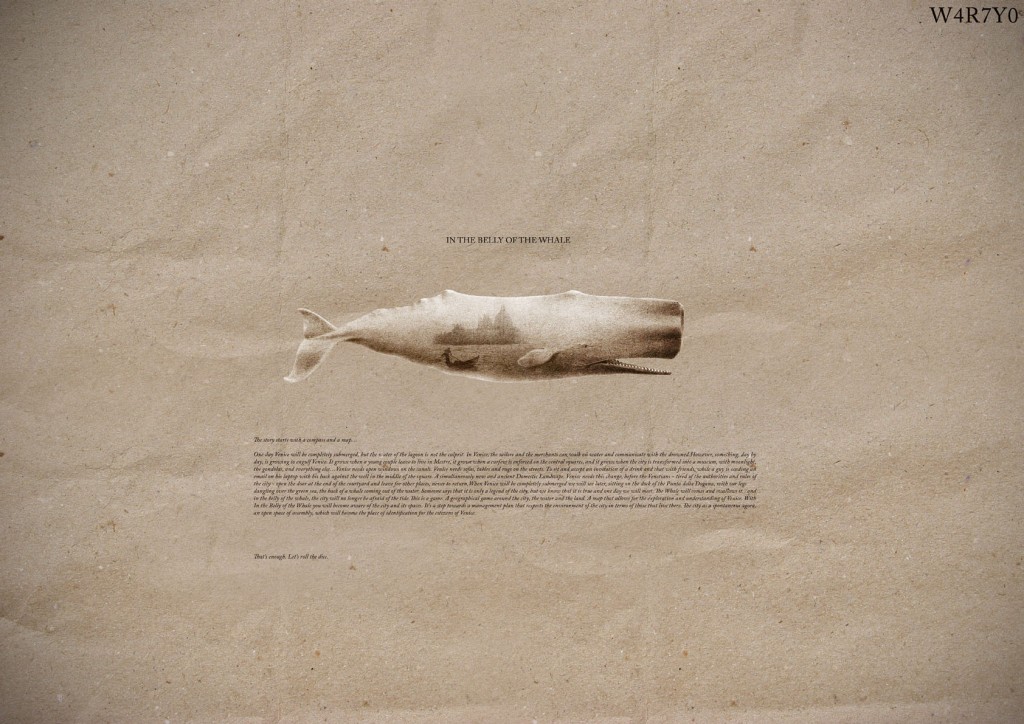Info:
Title: In the Belly of the Whale - Code: W4R7Y0Contest: Venice / 2011
By: M. Cervetti / C.
Views: 4600 Likes: 0
Votes:
BJARKE INGELS4 NERI OXMAN9 ELENA MANFERDINI6 MARIA LUDOVICA TRAMONTIN5 BOSTJAN VUGA15.0
In the Belly of the Whale
In the Belly of the Whale Marco Polo said: “The inferno of the living is not something that will be; if there is one, it is what is already here, the inferno where we live every day, that we form by being together. There are two ways to escape suffering it. The first is easy for many: accept the inferno and become such a part of it that you can no longer see it. The second is risky and demands constant vigilance and apprehension: seek and learn to recognize who and what, in the midst of the inferno, are not inferno, then make them endure, give them space.”
(Italo Calvino, Invisibles Cities)
The story starts with a compass and a map, like all tales about sailors and merchants…
We will see later, sitting on the dock of the Punta della Dogana, with our legs dangling over the green sea, the back of a whale coming out of the water. Someone says that it is only a legend of the city, but we know that it is true and one day we will meet.
Venice is a city consumed by history and by those that live there, even more than by the sea that surrounds it.
It is a series of spaces recovered from the crevasses of time: streets with the names of ancient professionals, corners where the dust accumulates with the stories, until the next high water. Venice was a gamble: wooden poles floating in the lagoon to raise monuments of stone. A ship’s bow to the east: the port of different religions, goods, men with different stories speaking different languages.
A city like that, you think would be eternal, unchanging. But unchanging Venice has never been, thanks to the water at its foundations and the designers of its construction.
If we take a closer look at Venice we can think it is not a city. Rather, it is a large house made of open rooms over the canals with its inhabitants taking to the streets with the furniture of their homes, turning calli and campi into living rooms with sofas, rugs and wooden chairs. And even places to store and hide items; in the cracks of the walls you will always have a corkscrew to hand.
The landscape of Venice is a Domestic Landscape. It is a place where the particular is essential to the general. Where hidden corners, the unknown, are the backbone of the city; the city you see in the glossy magazines. It is a place where the private and public are confused: where the street, even if punctured and punctuated with water, is the true protagonist. In this sense, Venice is the paradigm of the city and its raison d’être. For this reason, perhaps, Venice was for centuries the home of trade, full of merchants and sailors never had a fear of water; they simply used it like the pavement.
If one day this labyrinth of streets and bridges will be submerged, it will not be by the water of the lagoon. Infact, day after day, something else floods Venice: the stifling of the commentary of the latest group of tourists and the silence of the empty houses. A fascinating scene is played out here, where there is no place for actors, but only for a cast of extras.
So what is disappearing, under the impotent eyes of the planners and the men in power, are the places representative of citizenship; the elements that allow the recognition of territory and with it are rights to have spaces of meeting, exchange and learning.
Recognising the territory means to restore the geographic value of the city. Without this, the scale of the places where we live lose their meaning, together with our active role in citizenship: our participation in change.
Our proposal is based on this assumption and, in particular, on the idea that Venice needs a management plan aimed at the effective exploration of the domestic properties and details of its public spaces. In order to transform a city that is a museum, only concerned with looking towards its past, we need an active laboratory where history is merged with the present and the future. An urban workshop aimed at the restructuring of urban spaces for its inhabitants.
In this sense comes the need for a map that can describe those invisible boundaries of the dynamics underlying social, political, economic and environmental forces that are involved in urban change.
Our vision starts with three points that we consider fundamental in triggering the mechanism of development in the city:
- the formation of an “awareness”, derived from the knowledge that the citizen has of the environment in which they live.
- the “sharing” of a collective vision of the future of the city that has its base in the knowledge of the morphology and awareness of the cognitive and social mechanisms behind the use of the urban space (the street as the protagonist).
- the “representation” of the invisible and dynamic boundaries; the need for an effective mapping that is able to communicate the elements of complexity of the city.
In the Belly of the Whale is a game that guides us through the city and offers ideas for a new model of urban planning, identifying the problems and potential of Venice.
A game of geography thats goal is the understanding of Venice, and consequently, the design of a management plan that is able to enhance the environment for those that live there.
The story starts with a compass and a map.
Info:
Title: In the Belly of the Whale
Time: 6 giugno 2011
Category: Venice
Views: 4600 Likes: 0
Tags: Adriatic Sea , Cervetti , Italo Calvino , Marco Polo , Rome , Scripps Institution of Oceanography , Social Sciences , Venice , Water , WONDER Gansert









